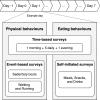Ecological momentary assessment of physical and eating behaviours: The WEALTH feasibility and optimisation study with recommendations for large-scale data collection
- PMID: 39932907
- PMCID: PMC11813119
- DOI: 10.1371/journal.pone.0318772
Ecological momentary assessment of physical and eating behaviours: The WEALTH feasibility and optimisation study with recommendations for large-scale data collection
Abstract
Ecological Momentary Assessment (EMA) enables the real-time capture of health-related behaviours, their situational contexts, and associated subjective experiences. This study aimed to evaluate the feasibility of an EMA targeting physical and eating behaviours, optimise its protocol, and provide recommendations for future large-scale EMA data collections. The study involved 52 participants (age 31±9 years, 56% females) from Czechia, France, Germany, and Ireland completing a 9-day free-living EMA protocol using the HealthReact platform connected to a Fitbit tracker. The EMA protocol included time-based (7/day), event-based (up to 10/day), and self-initiated surveys, each containing 8 to 17 items assessing physical and eating behaviours and related contextual factors such as affective states, location, and company. Qualitative insights were gathered from post-EMA feedback interviews. Compliance was low (median 49%), particularly for event-based surveys (median 34%), and declined over time. Many participants were unable or unwilling to complete surveys in certain contexts (e.g., when with family), faced interference with their daily schedules, and encountered occasional technical issues, suggesting the need for thorough initial training, an individualised protocol, and systematic compliance monitoring. The number of event-based surveys was less than desired for the study, with a median of 2.4/day for sedentary events, when 4 were targeted, and 0.9/day for walking events, when 3 were targeted. Conducting simulations using participants' Fitbit data allowed for optimising the triggering rules, achieving the desired median number of sedentary and walking surveys (3.9/day for both) in similar populations. Self-initiated reports of meals and drinks yielded more reports than those prompted in time-based and event-based EMA surveys, suggesting that self-initiated surveys might better reflect actual eating behaviours. This study highlights the importance of assessing feasibility and optimising EMA protocols to enhance subsequent compliance and data quality. Conducting pre-tests to refine protocols and procedures, including simulations using participants' activity data for optimal event-based triggering rules, is crucial for successful large-scale data collection in EMA studies of physical and eating behaviours.
Copyright: © 2025 Janek et al. This is an open access article distributed under the terms of the Creative Commons Attribution License, which permits unrestricted use, distribution, and reproduction in any medium, provided the original author and source are credited.
Conflict of interest statement
The authors have declared that no competing interests exist.
Figures


Similar articles
-
Sensor-triggered ecological momentary assessment in physical activity and sedentary behaviour research among Belgian community-dwelling elderly: lessons learnt from intensive longitudinal studies.BMJ Open. 2025 Apr 3;15(4):e096327. doi: 10.1136/bmjopen-2024-096327. BMJ Open. 2025. PMID: 40180404 Free PMC article.
-
Capturing Everyday Parental Feeding Practices and Eating Behaviors of 3- to 5-Year-Old Children With Avid Eating Behavior: Ecological Momentary Assessment Feasibility and Acceptability Study.JMIR Form Res. 2025 Feb 27;9:e66807. doi: 10.2196/66807. JMIR Form Res. 2025. PMID: 40014004 Free PMC article.
-
Contexts, affective and physical states and their variations during physical activity in older adults: an intensive longitudinal study with sensor-triggered event-based ecological momentary assessments.Int J Behav Nutr Phys Act. 2025 Mar 7;22(1):30. doi: 10.1186/s12966-025-01724-9. Int J Behav Nutr Phys Act. 2025. PMID: 40055798 Free PMC article.
-
Compliance With Mobile Ecological Momentary Assessment Protocols in Children and Adolescents: A Systematic Review and Meta-Analysis.J Med Internet Res. 2017 Apr 26;19(4):e132. doi: 10.2196/jmir.6641. J Med Internet Res. 2017. PMID: 28446418 Free PMC article.
-
Content validity and methodological considerations in ecological momentary assessment studies on physical activity and sedentary behaviour: a systematic review.Int J Behav Nutr Phys Act. 2020 Mar 10;17(1):35. doi: 10.1186/s12966-020-00932-9. Int J Behav Nutr Phys Act. 2020. PMID: 32151251 Free PMC article.
Cited by
-
Sensor-triggered ecological momentary assessment in physical activity and sedentary behaviour research among Belgian community-dwelling elderly: lessons learnt from intensive longitudinal studies.BMJ Open. 2025 Apr 3;15(4):e096327. doi: 10.1136/bmjopen-2024-096327. BMJ Open. 2025. PMID: 40180404 Free PMC article.
References
-
- Rosas LG, Mensink GBM, Finger JD, Schienkiewitz A, Do S, Wolters M, et al.. Selection of key indicators for European policy monitoring and surveillance for dietary behaviour, physical activity and sedentary behaviour. Int J Behav Nutr Phys Act. 2021;18: 48. doi: 10.1186/s12966-021-01111-0 - DOI - PMC - PubMed
MeSH terms
LinkOut - more resources
Full Text Sources
Medical
Research Materials

